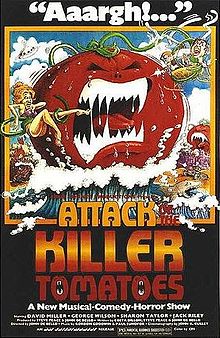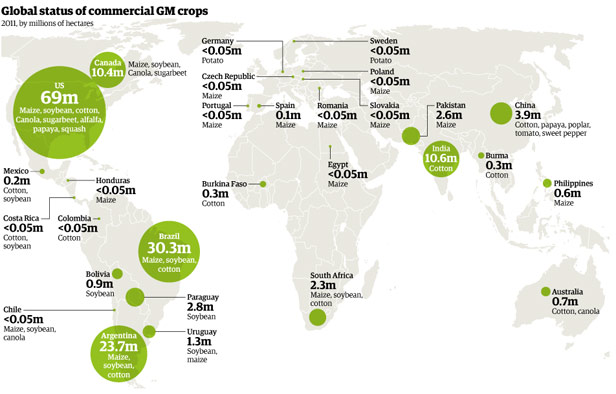The Continuing Saga of the Genetically Modified Plant


GM (Genetically Modified) Foods
“Jack! Did you see that potato move?! He’s a GM, that one, he’s sprouted eyes and I bet he’ll grow legs next! He’s gonna round up his buddies and take over the farm!”
That opening is ridiculous because farmers are a wise group of people and genetic modification of crops will not result in potato mutagenesis as described above. Attack of the Killer Tomatoes was, and will be, fiction.
With Halloween approaching and food policy on the minds of mayoral and national governments, I thought it a fine time to take a look at Frankenfoods – or genetic engineering of the fruits, vegetables, fish and meat we put in our bodies for sustenance.
Is any other industry so terrifying, causing such alarm among mothers, farmers and politicians? Genetically modified foods first hit the market in 1994, (Remember the Flavr Savr tomato from Calgene?), long before labelling actually informed us of what we were or were not consuming. In the early 2000s there was quite an uproar over the Frankenfoods, the harm, the danger they could cause. The media on a frenzy capturing shots of protesters destroying fields of GM crops. After a bit of a lull, it seems the rhetoric and debate on GM crops and foodstuffs has risen again. Mainly, over labelling of GMO food products in California and a more recent transgenic grain scare in Europe.
I wrote many a research paper in college on the topic of GM crops and foods. One of my favourites was titled The Continuing Saga of the Genetically Modified Plant. During college, I also worked at the Donald Danforth Plant Science Center, inserting drought-resistant genes into cassava plants to monitor the geminivirus. Being the forward thinker and planner I am, I was concerned about biosafety and further looked into the protocols that were (or were not) in place regarding the policies of introducing transgenic plants to developing countries. It seems we have come quite a long way. I say that because of this graphic from The Guardian of where the most GM crops were grown in 2011. No shocker the United States is out front with 69 million hectares. But take a look at the next few countries in line with the highest yields: #2 Brazil, #3 Argentina, #4 India, #5 Canada, #6 China. About 2/3 of that growth in GM crops occurred in developing nations. Kind of makes your mind wander down a lane of speculation, doesn’t it? Even the European Union has some small GM crop yields; the EU playing host to where many a protest took place in the early GM battle days.

Food Policy
When we talk about GM food policy, we really have to keep in mind the bigger topic of food production in general. And this discussion includes many variables – population, hunger, nutrition, environment. And I think population is perhaps the biggest obstacle we face. Think about it: we’re at something like 6.97 billion people right now, and projected to reach 9 billion by 2050. We’re looking at something like a 70% increase in food demand during this time. According to the World Bank, we have 1 billion already around the globe that do not have enough to eat. And we have seemingly insurmountable environmental challenges looming over our heads. Given these stressors, and those of viruses, diseases, herbicides and insects, I do not believe that farming (large scale production) is possible without genetic engineering.
GM in Your World
GM crops are transformed into all sorts of food that we consume; processed food being the biggest culprit – candy, bread, potato chips. Soybeans in particular can be found in just about every food under the sun. Most of the vegetable oil used in the U.S. is produced from GM crops. Bet most folks are not aware of that. There is none, or next to none, of the protein or DNA remaining in the vegetable oil from the orignal GM crop; it is removed during the refining process. In the case of sugar beets that are glyphosate-resistant (herbicide-tolerant), same thing. The sugar is highly refined, containing no protein or DNA; it’s just sucrose. At some point, chemistry takes over. GM could be looked at as a means to an end – to produce the vast amount of food that will be necessary.
We have the science, but we need to do a better job with the education and communication, in helping the public understand the food industry. And that means having our policy house in order as well. The issue of genetic modification will be continue to be debated and I can certainly see it becoming bigger as we face environmental factors unknown to us at present. It will also play a role as nations create, draft and modify plans for food security and biosecurity.
For now, I leave you with this: to date, there’s no scientific evidence for health or environmental risks from GM crops. Think about what your world may have been like today if scientists hadn’t spent hours in the lab perfecting genetic engineering.
Burnes K (2012-10-25 00:29:56). The Continuing Saga of the Genetically Modified Plant. Australian Science. Retrieved: Jul 18, 2025, from https://ozscience.com/news/the-continuing-saga-of-the-genetically-modified-plant/
 Follow
Follow